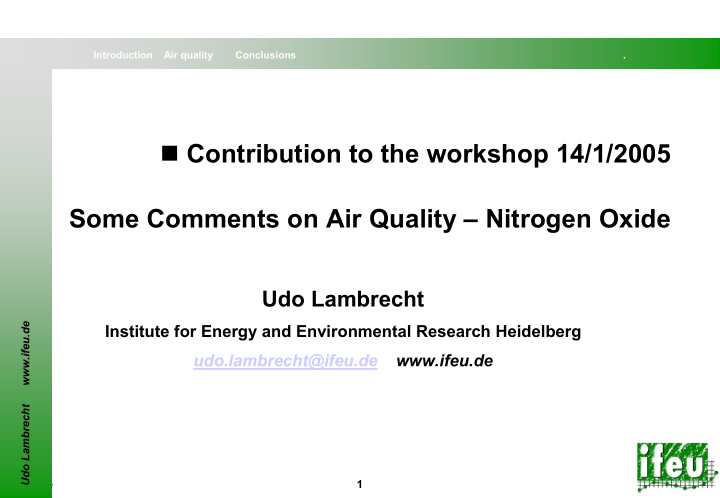



Introduction Air quality Conclusions . � Contribution to the workshop 14/1/2005 Some Comments on Air Quality – Nitrogen Oxide Udo Lambrecht Udo Lambrecht www.ifeu.de Institute for Energy and Environmental Research Heidelberg udo.lambrecht@ifeu.de www.ifeu.de 1
Introduction Introduction Air quality Conclusions . Introduction � The atmospheric concentration of CO and Benzene in Germany is already below future air quality standards. � Like in other countries: The concentration of nitrogen dioxide and PM10 exceeds air quality standards at several measurement sites – especially near busy streets. � This calls for a reduction of motor vehicle emissions. Buses contribute an average 10%, locally even more, to total urban NO x -emissions of road transport in Germany. Thus captive fleets should contribute to emission reductions. Udo Lambrecht www.ifeu.de � The formation of both pollutants [PM10 and NO 2 ] is complex and a reduction strategy requires a detailed analysis. � Problems of emission reduction strategies will be exemplified for nitrogen oxides. 2
Air quality in Germany – Emissions in urban areas Introduction Air quality Conclusions Air quality . � Decreasing nitrogen oxide 300 NOx (kt/year) - urban areas emissions: 1994 – 2002 about 30% in Germany Other PC Diesel 250 PC Gasoline � Share of heavy duty vehicles is Heavy Duty Light Duty continuously increasing Bus 200 � Share of buses is constantly about 10% in German urban traffic 150 � Not many data available on taxis Udo Lambrecht www.ifeu.de and other captive fleets 100 � Huge differences between cities and regions 50 Busses 0 1994 1998 2002 2006 2010 Source: TREMOD calculations [Version Nov. 2003] 3
Air quality in Germany – road side measurements – NO 2 Introduction Air quality Conclusions Air quality . Air quality - NOx - urban areas � Nitrogen oxide concentrations at busy streets in Germany have road side measurements NRW decreased by 50% since 1990 250 NO NO2 � Nitrogen oxides are composed of nitrogen monoxide (NO) and 200 nitrogen dioxide (NO 2 ), which annual mean NO 2 ug/m 3 exist in a chemical balance 150 � NO pollution has been decreasing considerably 100 Udo Lambrecht www.ifeu.de � NO is relatively harmless for human health 50 � NO 2 pollution on the other hand has not been decreasing 0 1989 1991 1993 1995 1997 1999 2001 2003 4
Air quality in Germany – road side – NO 2 Introduction Air quality Conclusions Air quality . � Air quality limits have been Air quality - NO 2 - road side 90 exceeded in 2003 in 10 (from 16) Near bus-stop federal states 80 � Increasing NO 2 concentrations in 70 recent years at many sites 60 � Possible causes: Annual mean ug/m3 50 � Meteorological and chemical limit 2010 environment conditions 40 � Higher shares of NO 2 in combustion Udo Lambrecht www.ifeu.de exhaust (e.g. caused by oxidation 30 Berlin - Straße catalysts and CRT systems for diesel NRW - Straße vehicles) 20 Stuttgart-Mitte Str. Karlsruhe - Straße � This has to be taken into account 10 for pollution reduction strategies 0 1987 1989 1991 1993 1995 1997 1999 2001 2003 5
Air quality in Germany – Emission city buses urban areas Introduction Air quality Conclusions Air quality . 16.000 � Emissions are decreasing due to NOx (kt/a) - bus fleet Germany the replacement of old buses 14.000 with new buses EURO 5 EURO 4 EURO 3 � The contribution of pre EURO 3 12.000 EURO 2 EURO 1 buses to NO x emissions is before EURO 1 currently about 80% 10.000 � The contribution of pre EURO 2 8.000 buses to NO x emissions is currently about 40% 6.000 Udo Lambrecht www.ifeu.de � Fleet composition varies 4.000 considerably between different cities. Example: 2.000 � Berlin: 1000 out of 1300 buses equipped with CRT (> 75%) 0 1994 1996 1998 2000 2002 2004 2006 2008 2010 � Germany: 8000 out of 25‘000 (30%) Source: TREMOD calculations [Version Nov. 2003] 6
Air quality in Germany – Emission City Busses – NO 2 Introduction Air quality Conclusions Air quality . NOx emissions of city busses (urban) � The use of CRT systems leads to 14 an increase in direct NO 2 NO NO2 emissions of busses 12 � This considerably increase could be one reason for increasing 10 local NO 2 concentration at several German cities 8 6 Udo Lambrecht www.ifeu.de 4 2 Data: IFEU assumptions 0 based on several sources Euro 2 Euro 2 CRT Euro 3 Euro 3 CRT 7
Air quality in Germany – Emission Passenger Cars – NO 2 Introduction Air quality Conclusions Air quality . NOx emissions of Passenger Cars (urban) � The introduction of oxidation 0,8 catalysts (passenger cars – NO NO2 diesel) also led to higher direct 0,7 NO 2 -emissions 0,6 � Considering the high increase of diesel cars in Germany, this also 0,5 could be one reason for 0,4 increasing NO 2 concentrations 0,3 Udo Lambrecht www.ifeu.de 0,2 0,1 0,0 Euro 1 Euro 2 Euro 3 Euro 2 Euro 3 no cat. oxidation cat. oxidation cat. 3-way cat. 3-way cat. Data: IFEU assumptions PC Diesel PC Gasoline based on several sources 8
Conclusions Introduction Air quality Conclusions Conclusions . � A reduction of road traffic and thus also of captive fleet emissions is necessary, because air quality limits are still exceeded. � The formation of PM and nitrogen oxides is complex and a projection as well as the monitoring of reduction measures difficult. � Besides the reduction of PM, the reduction of nitrogen oxides Udo Lambrecht www.ifeu.de has to be the focus of future strategies in Germany and Europe in order to comply with future air quality standards. � The influence of CRT-systems and Oxidation-catalysts on direct NO 2 -emissions has to be considered. In many air quality models input data are only NO X -emissions of transport. 9
Recommend
More recommend